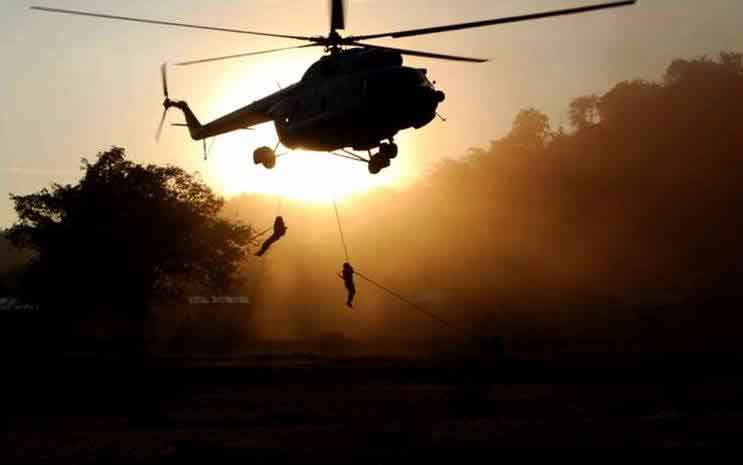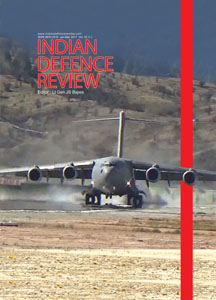With all the churning and regurgitation on the national security canvas, as it gets closer and closer to every citizen in today’s world, how do we develop our national security awareness and its content and how do we contribute to a sturdy, bold, innovative development of our nation? How much of our past, our psyche, our culture, our inherited mental attitude are effectively helping us to forge, develop, hone and strengthen our nation and ourselves to assert our right and place in the international sun? How are we going to secure that development so hardily forged? Today’s national security development has delivered twin soldiers – a professional soldier and a civilian citizen soldier. How do they operate, co-operate or contribute?
We have nurtured an elephantine mindset of allowing a problem to solve itself on its own…
Machines, communication, quick movement, increasing trade and commerce, interstate adjustments and dependence as also fast progressing world affairs have created strong pulls and competition among nations. Nationalism, national interest, national security and national progress have brought national assertion up front. That necessitates national strength, national power, the national will to assert, to compete with the rest of the nations and powers. This is not mere physical, mental or moral strength, but an amalgam of all these including, in the main, economic strength, diplomatic strength, techno-industrial strength, social strength and armed strength. All these are interdependent and mutual promoters. What is armed strength without economic strength, or diplomatic strength without armed strength, what can armed strength do without social strength; without technological strength? It is an intricate circle.
Armed strength is the last resort of the use of force and destruction or in collusion with other strengths when the situation so demands. Over millennia, it has virtually become the main force – not only in its actual use, but even in the very threat of its use. Two instances – we destroyed military facilities in Karachi through a naval attack in the 1971 war. Pakistan brought in China through seeking its help in developing the port of Gwadar and building a road from Sinkiang to Gwadar through its territory. In a future Indo-Pak confrontation, China’s entry has to be catered for. Second, Pakistan’s conventional military weakness in waging war with India has been mitigated by the former’s threat to unleash atomic weapons.
A brief review of our military past will be useful. Military force and its use are not merely one’s bravery, spirit, sacrifice, patriotism – all of them abstract and psychological factors – but very pertinently closely related to the thorough study and formulation of principles, theories, methodology, innovation and vision, technology and creative thinking on the use of force. This aspect has been noticeably missing in our civilizational philosophy on military matters.
Economic wars, indirect wars of the flea, wars of insurgency, proxy wars and the like are the order of the day…
The earliest thinker of note and content was Chanakya (300 BC), a wise, if also ruthlessly pragmatic, champion of Koota yuddha; followed by Manu (first century BC), Kamandaka (fourth century AD), with in between, Patanjali indicating the foreigner’s threat, and Panchatantra going on the premise of war being inevitable, then Kalidasa’s Raghuvamsha highlighting (Gupta contemporary) cavalry and its mobile warfare versus entrenched strategic defence, and then Bana’s Harshacharita indicating the use of various organisations and weapons in the seventh century AD. Shukra’s Neetisara of the ninth century AD deals with the art of fighting a battle with a three to one superiority (relevant even today) keeping reserves, and offering holding attack frontally and sending main forces on the enemy’s wings. He also refreshingly expounds the tactic of retreating to draw the enemy in unfavourable terrain and launching a counterattack. Kalyana Chalukya Someshwar’s Manasollasa almost follows the Chanakyan line – 12th century AD.
That brings Indian war thinking and cogitation on defence to an end. Enter Abdul Sarhindi of Delhi Sultanate – 12th century AD, Taimur’s record of 1405 AD, Babarnamah of early 15th century AD, the Akbarnamah of 16th century and the Jahangirnamah of 17th century AD. The last of the flashes is that of the strategy and tactic of Shivaji and Bajirao Peshwa of the 17th and 18th centuries which witnessed a brainy mix of static defence (forts) and mobile aggression (cavalry). Bajirao’s cavalry campaign that took his horse to water on the Indus near Attok and his Palkhed campaign against the Nizam find mention in the annals of the study of wars of the world. But we remember Bajirao only in the company of Mastani! That is our mental inclination.
In short, the indigenous cogitation on war and soldiering came to an end in the tenth century AD and India handed over her security to successive Afghan, Iranian, Turkish, Moghul and British conquerors. Most of these conquerors right down to the Moghuls, fell prey to the charms of Indian indifference to matters of defence, to the grandeur of vast number and to the mental sluggishness caused by the ease and plentitude of the continental soil and climate. In fact, the ‘Moghulai Fauz’ became so slow moving as to cover five miles a day, something close to the sluggishness of Someshwara’s army in his Manasollasa. The Indian brawn and bravery remained alive, but the brain and enquiry fell off. The British grabbed the brawn and gave it their brain and leadership, to shape a formidable military power in their hands to subjugate the very Indian subcontinent and rule it for two centuries and also to assert their primacy in the two World Wars with its help.
Just to lend verbal support to Baloch people’s struggle against the Pakistani government, it took us nearly seven decades…
What do we extract from the review of our past that is of military significance?
• We lost out to every foreign conqueror and in our attempt to socialise with them and save our identity, we managed to absorb them in our religion and society, from Shakas, Parthians, Huns, and Kushans. Muslim and Christian invaders refused to be absorbed and there rose the present Indian socio-political problem, that, in my opinion, is affecting the nation’s security. The repeated characteristic of ours – unity in diversity has worked perhaps culturally, but far less effectively politically.
• We have uniquely struggled to survive – we have bent over backwards to accommodate every invader and survived the storm. Like grass not being uprooted by even an earthquake or a tsunami; but also never growing tall. A desperate strategy of survival, hesitation to fight hard or to go for the kill, as a Pakistani author characterizes us. (So says Hasan Jawed in Husain Haqqani’s book- ‘Pakistan Between Mosque and Military’.)
• We fought among our own kingdoms and leaders, but buckled in front of the foreigner, for we fell short of new ideas, did not extend our vision beyond our geographical confines, neglected military cogitation, aggressive spirit and assertive resolve. An observation on our national security vision is relevant here. The British, in order to secure India, the jewel in their crown, extended their hold on Afghanistan, Iran, Tibet, Burma, Sri Lanka, Aden, Kenya, Malaysia and Indonesia. We lost not only all of them but also Pakistan and Bangladesh.
• And what about the birth of Pakistan? Through the 1920s, the British had sniffed the Indian urge for independence and in the 1930s, had almost come to acknowledge the near possibility of their having to depart from India. The astute strategic visionaries that they were, they had their eye on the Central Asian Kingdoms – Tajikistan, Turkmenistan and Kirghizstan, which were and still are, rich in natural resources, in addition to the Russian threat through them to Western India for an opening to the Arabian Sea. They were determined to retain control of Western India – the Indus sector – through any power that would replace them when they finally left India. For sure, they were convinced that the Congress-led government would not allow them this access. They then lent full support to Jinnah’s demand for Pakistan and Wavell, the Viceroy even partitioned India into two sectors. Through Pakistan in the West they could retain their influence in Central Asian lands. The Indian leadership had no such geopolitical awareness, leave aside vision! Looking beyond our cosy confines has never been our vision in matters of national security. Today, for a far delayed change, we are desperately trying to get access to Central Asian region through Iranian port of Chabahar and road-rail to Zahedan, bypassing Pakistan’s China-built Gwadar port. China has replaced Russia and has come South to the Arabian Sea and we are now attempting to go up North to Central Asia through the Arabian Sea.
Pakistan lacks that kind of power but has developed clout and support that emboldens it to use it aggressively…
We have developed a few of our typical Indian characteristics vis-à-vis our national security.
• Socio-politically we have a cultural division among our polity –viz. Heartlanders and Peripherals. Heartlanders form UP, Bihar, MP, Bengal – the Ganges-Yamuna belt. Psychologically, spiritually, identity-wise, religiously, philosophically it virtually rules the entire nation. The Ganges is our ‘be all’. Even Sri Lanka is mesmerised by Ganges. Their main river is Mahaveli Ganga. Peripherals are of several genre:
- Territorially – Jammu and Kashmir, the North Eastern states, all those seven sisters, a time was when even Punjab and Tamil Nadu were on the brink.
- Socially – Dalits, SC-ST, BCs and Naxalites
- Religion-wise – Minority Communities – Muslims, Christians, Buddhists and animists.
- Anthropologically – Tribals of all hue
- Gender-wise – Women
- Linguistically – Dravidian and North Eastern animist linguists.
Almost all our internal security problems relate to these peripherals, neglected by the heartlanders and allow our enemies to exploit those.
• Second, we have nurtured an elephantine mindset of allowing a problem to solve itself on its own, or by somebody, sometime, somehow. Problems drag on for years and decades. The AFSPA, that draconian law has been in force in the North East for nearly 60 years and in Jammu and Kashmir for thirty years.
• We have a sentimental affinity for dead soldiers and honouring them, but hardly any concern for living soldiers’ combat readiness in terms of their modern weapons, equipment and infrastructural facilities to fight opponents, especially on the Northern and Eastern borders.







Fabulous article boss
Thanks for information
Great job
Tc